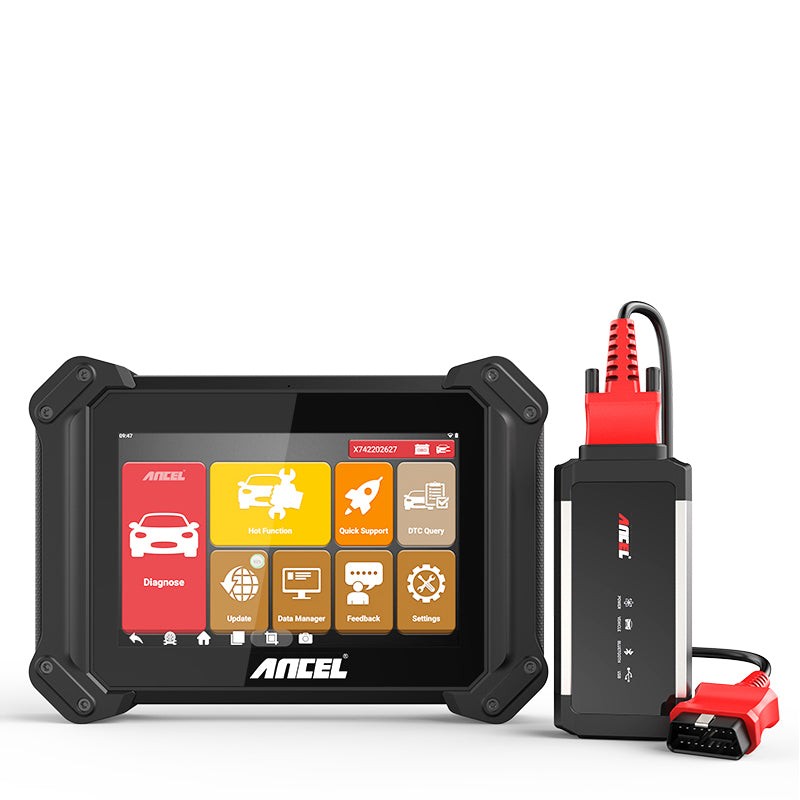Knowing the diagnostic history of your vehicle is crucial, whether you’re troubleshooting engine issues or evaluating a used car. A key question many car owners and potential buyers ask is: “Can an OBD2 reader check when codes were cleared?” As a seasoned auto repair expert at techcarusa.com, I’m here to provide a comprehensive guide on how OBD2 scanners can reveal if and when diagnostic trouble codes (DTCs) have been erased. This insight is invaluable for understanding your car’s health and ensuring transparency, especially in the used car market.
The Significance of Knowing if OBD2 Codes Were Cleared
Imagine inspecting a used vehicle that appears flawless – no warning lights illuminate the dashboard, and the engine runs smoothly. However, what if the seller recently cleared the fault codes to mask underlying problems? This scenario highlights why understanding if and when OBD2 codes were cleared is paramount.
Cleared codes can conceal significant mechanical or electrical issues that could lead to costly repairs down the line. For car owners, recognizing cleared codes can help distinguish between resolved problems and potential hidden faults. For used car buyers, this knowledge is even more critical, allowing for a more informed purchase decision and preventing future surprises.
Related Reading: Understanding How to Clear Codes on Cars with Scanners
Essential Tools for Checking OBD2 Codes and Clear History
To determine if and when OBD2 codes were cleared, you’ll need an OBD2 scanner. This car diagnostic tool connects to your vehicle’s onboard computer system, providing access to a wealth of diagnostic information, including current and historical fault codes, freeze frame data, and readiness monitor status.
Various OBD2 scanners are available, ranging from basic handheld units to advanced professional-grade tools. Some popular and highly-regarded options include:
- ANCEL V6 Pro+ (Recommended for Comprehensive Diagnostics)
- BlueDriver Bluetooth Pro OBD-II Scanner (Excellent for Smartphone Integration)
- Innova 6100P OBD2 Scanner (User-Friendly and Feature-Rich)
- Autel MaxiCOM MK808 (Advanced Diagnostics for Professionals and Enthusiasts)
For the purpose of detecting cleared codes, it’s essential to choose an obd scanner professional that can access readiness monitors, freeze frame data, and ideally, code history. These features are key indicators of recent code clearing activities.
 Car Scanner | ANCEL
Car Scanner | ANCEL
Alt text: ANCEL V6 Pro+ Bluetooth bidirectional scan tool displaying vehicle diagnostic information on its color screen, highlighting its capability as a professional car diagnostic tool.
Step-by-Step Guide: Checking for Cleared Codes with an OBD2 Reader
Follow these steps to effectively use your OBD2 scanner to check if and when trouble codes were cleared in your vehicle’s system:
Step 1: Establish Connection with Your Car’s Diagnostic System
Begin by connecting your car diagnostic scanner to your vehicle’s OBD2 port. This port is typically located beneath the dashboard on the driver’s side. For a detailed guide on port location, refer to resources like “Where to Connect OBD2 Scanner.”
Ensure your vehicle’s ignition is turned to the “ON” position, without starting the engine. This activates the Engine Control Unit (ECU) and allows the scanner to communicate with the vehicle’s diagnostic system. As explained in “Is Your Engine Required to Be Running for Diagnostics, most diagnostic checks, including code retrieval and readiness monitor assessment, can be performed with the engine off, ignition on.
Once connected, your car scanner tool will power up and initiate communication with the ECU, preparing to retrieve diagnostic data.
Step 2: Accessing Diagnostic Trouble Codes (DTCs)
After successful connection, navigate your best obd scanner for all cars to the Diagnostic Trouble Codes (DTCs) section, often found in the main menu under “Diagnostics” or “Codes.” This area displays both active and pending codes. Active codes represent current issues, while pending codes indicate potential problems that haven’t yet triggered a fault light.
If the DTC section shows “No codes found,” it could mean the system is clear of faults or that codes were recently erased. An empty DTC log alone isn’t definitive proof of code clearing, as the vehicle might genuinely be issue-free at that moment. However, if you suspect recent issues or are inspecting a used car, further investigation is warranted. Note the number and nature of any codes present. A completely empty DTC history in a vehicle with known past problems is a potential red flag. Some advanced scanners may offer features to directly show the date of the last code clear, providing a more direct answer.
Step 3: Analyzing Freeze Frame Data
Freeze frame data is a snapshot of your vehicle’s operating parameters recorded by the ECU at the moment a DTC is triggered. This data set typically includes parameters like engine speed (RPM), engine load, coolant temperature, and vehicle speed. Access the “Freeze Frame” section of your car scanner diagnostic tool to review this information.
Missing or incomplete freeze frame data, or a timestamp that seems unusually recent, can suggest that codes were cleared to hide a problem. Ideally, freeze frame data should be present and correspond with any DTCs found. Discrepancies, such as very recent timestamps that don’t align with the vehicle’s history or operational context, should raise suspicion of code clearing. More sophisticated car scan tools may allow you to examine multiple freeze frames if several codes were previously active.
Step 4: Evaluating Readiness Monitor Status
Readiness monitors are self-tests run by the vehicle’s emission control system to ensure proper functioning. When DTCs are cleared, these monitors reset and must complete their tests through specific driving cycles. The time and driving conditions required for monitors to reset vary depending on the vehicle and the specific monitor.
Check the readiness monitor status, often found under “I/M Readiness” or “Monitors” in your wireless bluetooth obd2 scanner. The scanner will display the status of each monitor as “Complete” (tests passed), “Incomplete” (tests not yet run since reset), or “Not Supported” (not applicable to the vehicle).
If multiple monitors show as “Incomplete,” particularly after the vehicle has been driven a considerable distance, it strongly indicates recent code clearing. Under normal driving conditions, most monitors should reach a “Complete” status relatively quickly. Persistent “Incomplete” statuses suggest the vehicle hasn’t completed the necessary drive cycles post-reset, likely due to recent code erasure.
Step 5: Checking for Permanent Codes (P-DTCs)
Permanent codes, or P-DTCs, are a feature of OBD-II designed to prevent emission-related issues from being masked. Unlike regular DTCs, permanent codes cannot be cleared manually with a car diagnostic tool. They remain stored in the ECU until the system itself verifies that the fault is resolved over multiple drive cycles.
Look for a section labeled “Permanent DTCs” or similar in your scanner’s menu. The presence of permanent codes signifies unresolved issues, even if regular DTCs have been cleared. P-DTCs are a strong indicator that someone may have attempted to clear temporary codes to hide problems, but the underlying fault persists.
When evaluating a used car, permanent codes offer a more reliable picture of the vehicle’s condition, unaffected by recent code clearing attempts. If P-DTCs are present, further investigation and repair verification are crucial before purchase.
Step 6: Investigating the Code History (Advanced Scanners)
Advanced automotive scanner tools often provide a code history feature, logging past DTCs and related events. This historical data can reveal patterns of recurring issues that were repeatedly cleared without proper repair, or a sudden absence of codes suggesting recent tampering.
Access the code history section, sometimes labeled “DTC History” or “Diagnostic History,” via your scanner’s menu. This log may show previously detected and cleared codes, their frequency, the conditions under which they occurred, and whether they were manually cleared.
Analyzing the code history can reveal if a vehicle has a history of unresolved problems or if there’s evidence of recent system resets. Repeated instances of the same code in the history, now absent from active DTCs, suggest potential code clearing to hide persistent issues. Code history provides a deeper, more comprehensive diagnostic record than a simple DTC scan.
Extra Tips for Detecting Cleared Codes
- Utilize a High-Quality Scanner: While basic OBD2 scanners are useful, advanced models offer deeper diagnostics, manufacturer-specific codes, and more reliable access to readiness monitors and code history, crucial for detecting cleared codes effectively. For uncertain results, consult a professional mechanic with a high-end scanner.
- Observe Vehicle Symptoms: If your car exhibits symptoms like rough idling, reduced fuel economy, or intermittent warning lights, yet the scanner shows no codes, suspect recent code clearing. Don’t dismiss these symptoms based solely on a “clear” scan.
- Exercise Caution with Used Cars: Always scrutinize readiness monitors and freeze frame data when buying used vehicles. Unusual readiness monitor statuses or missing/recent freeze frame data are potential red flags indicating code clearing to conceal problems. Professional pre-purchase inspections are highly recommended, particularly if anything seems amiss.
Conclusion: Empowering Yourself with OBD2 Diagnostics
Whether you’re maintaining your vehicle or assessing a used car, using an OBD2 scanner to examine DTCs, freeze frame data, readiness monitors, permanent codes, and code history is essential for uncovering potential hidden issues. Proactive diagnostics empower you to make informed decisions and avoid costly surprises down the road. Understanding your car’s diagnostic story is always better than facing unexpected repairs later.
FAQs
How long should I drive after clearing codes before a vehicle inspection?
After clearing OBD2 codes, drive your car for at least 50-100 miles, incorporating varied driving conditions (city and highway), to allow readiness monitors to reset and ensure inspection readiness.
Can a dead battery cause diagnostic codes to clear?
Yes, a completely dead or disconnected battery can erase stored diagnostic codes by resetting the vehicle’s ECU. However, this also resets all readiness monitors, which will need to be re-established through driving cycles.
Does clearing codes erase all historical data from the ECU?
Clearing codes primarily removes active and pending DTCs. However, permanent codes and some diagnostic logs may persist in the ECU until the underlying issue is verified as resolved by the vehicle’s diagnostic system itself.
